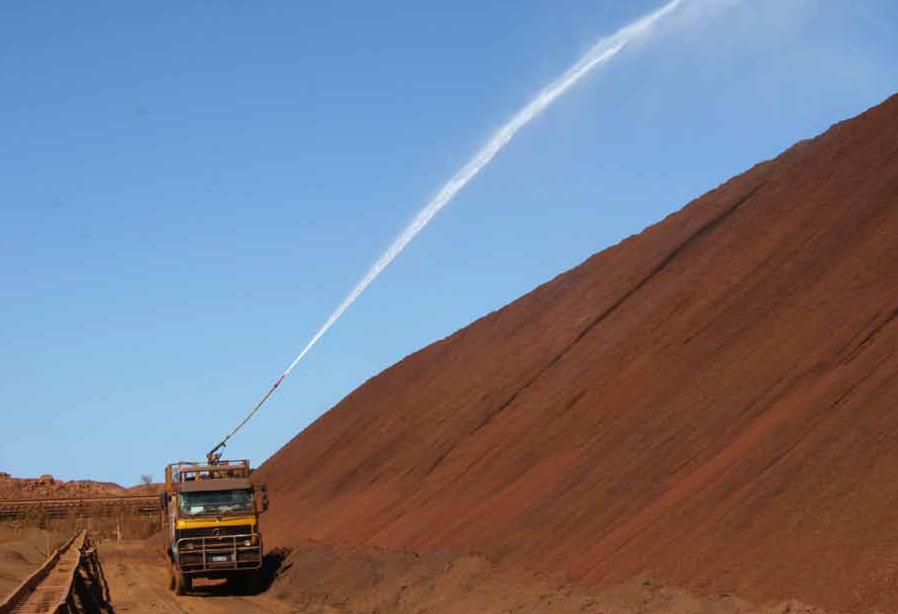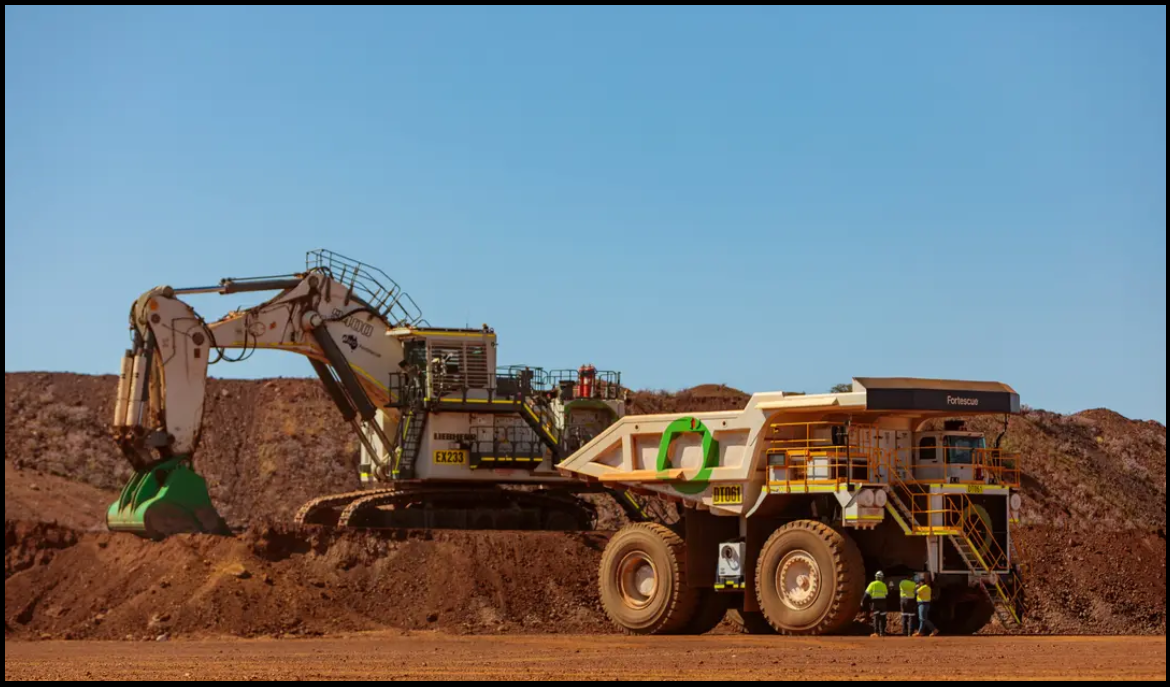
As the pressure intensifies on global industry to conserve water and hone efficiencies, solutions that reduce the need for water in dust control are in high demand. Rainstorm Dust Control is using its expertise, unique products and solid experience to lead a growing market.
When ore is mined, processes such as crushing, grinding and transporting generate large amounts of dust; as do the untreated roads carved out of dry earth to carry the vast number of vehicles essential to operations. Failure to control such large amounts of dust can reduce an operation’s efficiency, pose health and safety hazards, and cost a lot of time and money. Traditional methods dating back centuries either involve pumping copious amounts of water or, even worse, just putting up with it.
It tends to follow that the more predisposed a region is to dust, the less water it has available to help control it; so in dry climates, to throw water at the problem is no longer a viable long-term option. “The catchphrase we use is ‘Water on dust control is water lost’,” says Rainstorm Dust Control’s technical sales and marketing manager, Mason Trouchet. Consider also the added expense of flying water cart operators into remote mining sites, he says, and it becomes clear that an alternative to water is the only sensible way forward.
Headquartered in Maddington, Western Australia, Rainstorm Dust Control is a unique business in the world of dust control. Its suite of products is specifically designed to stop the dust from becoming airborne in the first place. Drawing on expertise gathered over the past 30 years, the company supplies both products and contractor services, running a range of specialised equipment to dispense the products or inject them into minerals.
For mining and civil projects, over 50 per cent of all dust is generated from unsealed roads. It’s the single largest contributor towards dust on almost all the projects Rainstorm works with. The company tackles road dust with DustMag, a world-leadingsolution trusted by mining giants such as BHP Billiton and Rio Tinto. Sprayed onto the roads, it works by pulling moisture from the atmosphere, so the road is effectively being continuously watered. When applied to unsealed or mine haul roads, no water is required for dust control for a period of between three to four months.
A lower value alternative to DustMag is the use of water extenders, where water containing special additives is used to suppress road dust. The additives encourage the water to penetrate further into the road surface. That said, Rainstorm’s preferred option is DustMag, because water extenders require specialised training to be given to whoever is spraying the water. “With DustMag, we have our own vehicles, we spray it on the road, and we disappear,” says Trouchet. “A DustMag application offers better cost control. And it keeps the water carts off the road, which is an added benefit from a health and safety point of view.”
The second largest dust generation source is wind erosion of open areas and stock piles. Australia has advanced warning systems in place that can forecast dust dispersion 48 hours ahead of time—including where the wind is coming from, at what speed, and where the dust is going to land. Rainstorm can react to these forecasts by spraying stockpiles with a veneer that forms a crust or film to prevent the material from lifting. The company usesGluon (polymers) and a range of hydro mulch and hydro seeding solutions to veneer surfaces, which, as well as stockpiles, can include rail cars and transport trucks, topsoil and green field developments.
The third dust generation source comes from materials handling, or the movement of a mineral, and Rainstorm’s approach is to manage the DEM (Dust Extinction Moisture point). This is the point at which after adding moisture into a mineral it no longer flies once it reaches a certain percentage (imagine adding water to a pile of flour and you get the idea). Of course, there is a fine line between adding too little moisture and adding too much, so Rainstorm has invented something unique to tackle this challenge—PDX (Point of Dust Extinction). This is a liquid biochemical used to reduce the DEM levels of fine-grade ores, by changingthe interface between the water and ultra-fine particles and through ion exchange, causing the ultra-fines to bind and drop.“The additive changes the water already present in the ore to be more efficient, so you achieve dust control at one, two or three percentage points lower in the DEM range which means you need to add less water to reach DEM. And that is unique,” says Trouchet.
PDX is highly concentrated, entirely biodegradable and non-toxic. An effective aid to wettability and friability, the method is cost-effective, as small amounts of PDX will treat a large volume of mineral for a minimal cost.
Demand is now growing for this product, Trouchet says, as iron ore and coal companies in particular struggle to find enough water to manage the dust in the millions of tons of volume they export. Shipping insurance companies are also becoming increasingly concerned with the free addition of water, due to the risk of ore liquefaction within the ships’ holds.
However preventing dust from flying is only half the story: what the industry refers to as ‘fugitive dust’ must also be tackled. Where large volumes of bulk materials are being handled, for example in crushing and screening plants or transfer hoppers, some dust will still escape, no matter how effective the dust control in other areas. To tackle this, Rainstorm uses fogging systems, designing, building and commissioning its own equipment for this purpose.“Instead of using large amounts of water to suppress the dust, we use low volumes of water at high pressure, or dry fog,” explains Trouchet. “We match the water particle size to the dust particle size so the two are attracted together. The weight of the dust particle is made heavier by the water molecule attaching to it and it drops to the ground. Many people use large water jet sprays, but that just pushes the dust out of the way—there’s no balance between the particle size and the water particle size.”
Rainstorm’s contracting expertise has been built upon its 30 years’ experience in growing and developing the dust control industry; and as water shortages and tighter environmental controls on dust increase, the sector looks set only to grow. As mines work to expand production, they must do so without any further damage to the environment: if they want to double production, they must make their dust control twice as effective. The last 10 years have seen a significant change towards dust control solutions and Rainstorm has been one of the largest and major contributors towards the growth of the industry. The old ways are now recognised as not being good enough and transition towards 21st century techniques and products is paying dividends by saving enormous amounts of water, money and hassle.
However, as with any rapidly growing industry, many smaller start-ups lacking the relevant expertise have been entering the market touting individual products. But Trouchet believes this is a short-sighted approach. “The product is not what it’s about,” he says. “The mining companies now are looking to receive a far more sophisticated service from their dust control suppliers: they want them to act as contractors and develop the specialised equipment required. A lot of companies have entered the market with a product for roads but they don’t offer veneering, ore treatment or fogging—we’re probably the only business in the world that handles everything, from pit to port. Whatever you need for your dust control, we can deliver it. We have a great deal of expertise in all facets of dust control, so if the solutions are not readily available we will create them to suit a client.”
With its global reach and access to consultants, atmospheric scientists and experts modelling EPA requirements in developing countries, Rainstorm is finding its products and services in increasingly high demand. “Africa and South America are looking at what we’re doing in Australia and wanting to do it too. But they don’t have to take years to develop these systems themselves, as we have done—they can buy it all now, off the shelf,” he concludes.
Written by Becky Done; research by Paul Bradley
DOWNLOAD
 Rainstorm-EMEA-Sept12-Bro-s.pdf
Rainstorm-EMEA-Sept12-Bro-s.pdf













